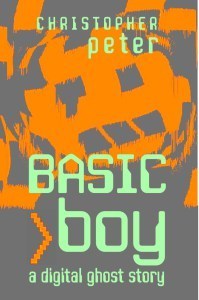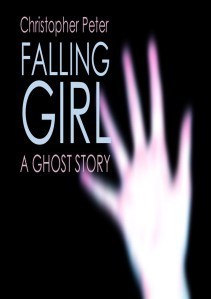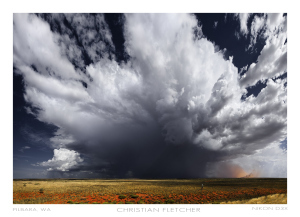Christopher Peter's Blog, page 10
March 26, 2014
Flash Fiction: Paradise House
Set in a grim housing estate, Paradise House is a story of loneliness, abuse and an unexpected act of kindness.


March 23, 2014
Falling Girl: A Ghost Story – part 6 of 7
I’m serialising my novel Falling Girl: A Ghost Story on this website. Each part is free to download. These two chapters form the penultimate instalment: Falling Girl – part 6
Next week, part 7, will be the very last chapter.
Previous instalments can be found on the Falling Girl page.
“This castle is haunted. It really is. There are ghosts in the walls and towers, the passages and the dark rooms, the secret places away from the warmth and sunshine, where it’s cold and clammy and … lonely.”
When eleven-year-old Ellie Black runs into Pentrillis Castle, she’s desperate to escape her depressing family life. Her parents have split up, Dad is Mr Angry, and her new step-brother is obnoxious beyond belief.
At first, it’s much better inside the castle. The sun shines (even when it’s still raining outside), there’s fabulous chocolate cake, and she meets a friendly story-teller and two cool new friends. (There’s also a scary bit in the chapel, but she was probably just imagining things, right?)
But the story-teller has a dark and unsettling tale to tell, of tragedy … and something menacing in the shadows.
And there’s some very odd things about those new friends.
And where did that awful scream come from?
But the worst part is when Ellie realises that there’s nowhere to hide from the ghost of Pentrillis Castle …


March 20, 2014
Should self-published authors think more about print?
Don’t get me wrong. I’ve embraced e-books as both reader and author, and it’s obvious that for the self-published writer the medium has compelling advantages. It has lowered or removed production and distribution costs. It’s enhanced the ability to sell online and so bypass both bookshops and the traditional gatekeepers of publishing. For these reasons it’s been a major factor in the explosion in the popularity of self-publishing.
Therefore the temptation, for many, is to ignore print completely. I don’t have any figures to back it up, but it’s very probable that a substantial proportion of self-published titles – perhaps even the majority – are available only as e-books, and often only in Kindle format.
But are we missing a trick by ignoring the humble printed book? It’s not just that I like them – though I do. In fact I still read them, tending to alternate between physical books and my Kindle. E-books are all very well, and their advantages are obvious, but sometimes you just can’t beat the look, feel and even smell of the printed page. (You just can’t sniff a Kindle. Or more accurately, you can, but (1) it doesn’t really smell of anything, and (2) it looks even weirder than sniffing a book.) And it’s just nice to have one part of my leisure time that doesn’t involve staring at a screen. Plus, the batteries never run out and it isn’t the end of the world if you drop in the bath. And probably no-one will steal it.
To be honest, that’s the main reason why I put both of my novels into Createspace, to make them available in paperback as well as Kindle editions: so that I could see my own work in print. (It certainly wasn’t the economics – more of that below.) Seeing my name (well, my writing name) printed on a spine on my bookshelf wasn’t my only motivation for starting to write, but I don’t think I’m alone when I admit it was a pretty big one.
And the point is, paper books aren’t going away any time soon. The ‘print is dead’ mantra always struck me as over-simplistic at best, tinged by a smug techno-arrogance (look at those Luddites clinging to their dead trees!), and mixed also I think with a kind of wishful thinking, the hope that one simple world (all is print) would be quickly and smoothly supplanted by another (all is e). The truth, as so often, has turned out rather more complicated.
It’s now widely known that e-book sales are levelling off. To some degree that was predictable – explosive, exponential growth cannot go on forever in anything. It doesn’t mean that e-books won’t dominate the future of reading – it’s hard to believe they won’t. And they will continue to grow and develop in ways that are hard or impossible to predict right now.
But print has proved a remarkably stubborn old goat. Take this article, which includes the startling statistic that among 1,400 16- to 24-year-olds in the UK, approximately 62% said they preferred print books over e-books. Yes I know – all statistics need to be taken with a bucket of salt – but it does seem that it’s not just oldies who are hanging on to their paper products; even the younger generation can see the point of print. It’s a pragmatic decision – which format is best for my needs? And those needs will vary depending on the situation. I’ll happily read an e-book, but I’d rather take an old-fashioned paperback onto the beach – the sand won’t bugger it up and no-one will sneak up and nick it when I doze off for five minutes.
But another statistic quoted in this article also caught my eye: that 60% of e-books downloaded in the US are never read. The very cheapness, the sheer ubiquity of the e-book may have become one of its biggest weaknesses. So easy and cheap – often free – vast numbers are crammed onto the world’s e-readers, far more than their owners could every realistically read in their lifetimes, doomed to gather digital dust. If you’re giving away your books for free to garner attention and the odd review, that’s sobering news. Not all paper books are read either, but they’re harder to ignore for ever when they sit looking accusingly at you from your bookshelf; and if you’ve paid more for it, the perceived value is higher.
Also, we forget the fact that not everyone has an e-reader. More people have tablets, but those all-singing, all-dancing devices aren’t necessarily the best for reading. It’s hard to concentrate on a book when the device keeps pinging every five minutes because you’ve got e-mail, and there’s the ever-present temptation of a quick game of Temple Raider.
So far, I’ve sold about as many paperbacks of my books as I’ve sold Kindle editions. Now I’m pretty sure that’s not everyone’s experience, and it’s also true I’ve sold very few of either, but still. I know that some people wouldn’t have bought my books at all if they weren’t available in paperback, even if they do cost more.
Cost. That brings me neatly onto one of the main drawbacks of Createspace and other ‘Print on Demand’ book programs. I know something about print technology, and it’s an unavoidable fact of POD that the cost per copy will always be that much higher. The very ability to produce single copies cost-effectively precludes any economies of scale. That’s why you can’t price your Createspace paperback as low as you’d like, and why you’ll never match the price points of the mega-sellers from James Patterson and J.K. Rowling. Their books are printed in thousands and tens of thousands at a time, on monster printing presses a world away from the glorified photocopiers that serve the POD market.
I’d love to be able to price my paperbacks lower than they are, but until recently I’ve had to put out both BASIC Boy and Falling Girl at US$5.99 / £4.99, much more than the Kindle editions, and that’s still making very little royalty per copy. The only way I could possibly price much lower would be to commission a high speculative print run, outside of POD, which would mean significant up-front costs running into thousands of pounds – and a house crammed with boxes of books. And how would I sell them? I think we all know that getting self-published books into the average bookshop is mission impossible.
Perhaps there are other channels though. I’ve toyed with the idea of a market stall, or perhaps a collaboration with other local self-published writers. But I haven’t yet been brave (or stupid?) enough to take that kind of risk. I have however donated copies of both books to my daughter’s high school library (much to her embarrassment). I figure that any exposure is a good thing, even if I make no money from it.
One thing I have done recently is to reformat the paperback edition of BASIC Boy. By reducing the text point size and margins and removing the table of contents (not really necessary in the paperback) I’ve managed to knock almost 20% off the page count, without compromising readability too much I hope, and that has enabled me to reduce the price to US$4.99 / £3.99. I plan to do the same with Falling Girl next. I’m not kidding myself that this will kick-start mega sales, but I just like the idea that people can buy my paperbacks for a slightly more reasonable price. And if I do want to buy any more books to sell on or give away – perhaps to more local libraries – then it’s become more affordable to do so.
At the same time I refreshed the covers, having noticed that the bright on-screen e-book colours became darker and murkier in the paperback, so I made the paperback edition colours lighter. The new cover designs are below (feedback very welcome!).
I’d be interested to hear of other people’s experience of selling their print books. How have sales compared to the e-book versions, and how and where have you sold them? I don’t have the answers; I just believe that there’s still a place for both the print book and the e-book, and the print may be able to offer additional opportunities that would be unwise to ignore.


March 17, 2014
Falling Girl: A Ghost Story – part 5 of 7
Over the next few weeks I’m serialising my novel Falling Girl: A Ghost Story on this website. Each part is free to download. Here’s the next two chapters: Falling Girl – part 5
Previous instalments can be found on the Falling Girl page.
“This castle is haunted. It really is. There are ghosts in the walls and towers, the passages and the dark rooms, the secret places away from the warmth and sunshine, where it’s cold and clammy and … lonely.”
When eleven-year-old Ellie Black runs into Pentrillis Castle, she’s desperate to escape her depressing family life. Her parents have split up, Dad is Mr Angry, and her new step-brother is obnoxious beyond belief.
At first, it’s much better inside the castle. The sun shines (even when it’s still raining outside), there’s fabulous chocolate cake, and she meets a friendly story-teller and two cool new friends. (There’s also a scary bit in the chapel, but she was probably just imagining things, right?)
But the story-teller has a dark and unsettling tale to tell, of tragedy … and something menacing in the shadows.
And there’s some very odd things about those new friends.
And where did that awful scream come from?
But the worst part is when Ellie realises that there’s nowhere to hide from the ghost of Pentrillis Castle …


March 14, 2014
Are men idiots?
A rhetorical question, you might say! Today I came across this article in a UK newspaper, and it got me thinking. (I usually blog about books or writing, but there is a connection – bear with me.)
The article contends that in modern, Western popular culture – in this case, television specifically – it has become commonplace for men to be portrayed in less than flattering ways. Certainly this can be seen in some advertising, where the male of the species are often seen to be shallow, simple and/or sex-obsessed, and frequently outwitted with ease by sassy, self-confident women.
Perhaps it’s the case that, quite rightly shy of overt sexism or racism, and possibly over-compensating for the overt gender stereotyping of the past (see below), mainstream advertisers have started to regard men as the easiest target.

For myself, as a man, I can see the article’s point, and I do think that some advertising is guilty of this. TV programmes, probably less so. (I don’t, for example, especially agree with his view about Outnumbered – yes, the dad in that show can be a bit wet, but so can the mum.) But equally I’m well aware that I live in a society where men still have it pretty good. Most top politicians, business executives and high earners still tend to be male – that’s changing, but slower than it ought to be. And it’s important to be able to laugh at ourselves – and let’s face it, most stereotypes have at least some basis in reality …
Anyway – how does this link to writing? Just the thought that it’s important to avoid lazy stereotypes when creating characters – because it’s very easy to do. Specifically, as we strive to draw strong, compelling and authentic female characters in our stories, we should beware of the temptation to short-change the males. Especially the older ones. This may be especially a risk in teen / YA fiction, in which the younger characters are centre-stage and the older ones tend to be in the background and therefore in danger of being merely one-dimensional and under-developed – and if they’re also men, the risk may be higher.
One adult male character, Rob Black, appears in both my novels Falling Girl and BASIC Boy (though in the latter he’s a teenager half the time too). He’s middle-aged and male – the kind of character who, in YA fiction, might not come across in a very positive way. I’ve tried to avoid that, and I hope I’ve succeeded. He’s certainly flawed, and many of this shortcomings are brought into sharp focus as the stories unfold, but so is a deep courage and determination. In the end it’s the kids who really save the day of course, but he helps and he’s clearly there to support them. He’s certainly not an idiot – not entirely anyway. Or at least I hope not.


March 9, 2014
Falling Girl: A Ghost Story – part 4 of 7
Over the next few weeks I’m serialising my novel Falling Girl: A Ghost Story on this website. Each part is free to download. Here’s the next two chapters: Falling Girl – part 4
Previous instalments can be found on the Falling Girl page.
“This castle is haunted. It really is. There are ghosts in the walls and towers, the passages and the dark rooms, the secret places away from the warmth and sunshine, where it’s cold and clammy and … lonely.”
When eleven-year-old Ellie Black runs into Pentrillis Castle, she’s desperate to escape her depressing family life. Her parents have split up, Dad is Mr Angry, and her new step-brother is obnoxious beyond belief.
At first, it’s much better inside the castle. The sun shines (even when it’s still raining outside), there’s fabulous chocolate cake, and she meets a friendly story-teller and two cool new friends. (There’s also a scary bit in the chapel, but she was probably just imagining things, right?)
But the story-teller has a dark and unsettling tale to tell, of tragedy … and something menacing in the shadows.
And there’s some very odd things about those new friends.
And where did that awful scream come from?
But the worst part is when Ellie realises that there’s nowhere to hide from the ghost of Pentrillis Castle …


March 7, 2014
Making short shorter: A Dramatic Way to Clear the Air
A Dramatic Way to Clear the Air is a 1,000 word story – kind of boy-meets-girl in a thunderstorm. It started life as a longer, 1,500 piece that I wrote about a year ago. Given my recent enthusiasm for shorter / flash fiction, I thought it would be an interesting exercise to try to cut it down – losing one out of every three words – while maintaining the essence of the story.
So I did, and it wasn’t as hard as I’d first imagined. I had to go through it a few times to hack away all those 500 words, but it was surprisingly satisfying – and I really think the shorter version is better. It’s tighter, more direct, has fewer adjectives, adverbs and description, and yet I don’t think it really loses anything in terms of story or the characters.
Sometimes losing word count is a case of cutting unnecessary repetition or elaboration. Often things can be implied rather than explicitly states. One example – the sentence:
She peered ostentatiously at the clock, spidery black eyebrows raised almost out of sight.
… was originally followed by:
The words “you’re late” could not have been more clearly spoken if they had been flashed in blue neon across the walls.
I kind of liked that second sentence, but I concluded that it was basically superfluous. The fact that the woman in question thinks that Pete (the central character) is late for work is clearly implied in the first sentence – it doesn’t really need to be spelt out. So that second sentence was cut completely from the final version.
If you’re interested to compare, the original, 1,500-word version is here: A Dramatic Way to Clear the Air – long version


March 2, 2014
Falling Girl: A Ghost Story – Part 3 of 7
Over the next few weeks I’m serialising my novel Falling Girl: A Ghost Story on this website. It will be downloadable for free. Here’s the next two chapters: Falling Girl – part 3
Previous instalments can be found on the Falling Girl page.
“This castle is haunted. It really is. There are ghosts in the walls and towers, the passages and the dark rooms, the secret places away from the warmth and sunshine, where it’s cold and clammy and … lonely.”
When eleven-year-old Ellie Black runs into Pentrillis Castle, she’s desperate to escape her depressing family life. Her parents have split up, Dad is Mr Angry, and her new step-brother is obnoxious beyond belief.
At first, it’s much better inside the castle. The sun shines (even when it’s still raining outside), there’s fabulous chocolate cake, and she meets a friendly story-teller and two cool new friends. (There’s also a scary bit in the chapel, but she was probably just imagining things, right?)
But the story-teller has a dark and unsettling tale to tell, of tragedy … and something menacing in the shadows.
And there’s some very odd things about those new friends.
And where did that awful scream come from?
But the worst part is when Ellie realises that there’s nowhere to hide from the ghost of Pentrillis Castle …


March 1, 2014
Finding the time to write
I admire my fellow bloggers. Many of them seem to write regularly, read diligently, and still find time to post several times a week. I don’t know how they do it. Managing my time is a constant struggle for me. As well as my writing I think it’s important to keep reading Then there’s the full-time day job of course. I don’t want to short-change my wife or kids – they need and deserve my time. And I do like to eat. And if I don’t get enough sleep my brain starts to shut down pretty quickly.
(I shouldn’t complain too much of course. I’m well aware that I have many things to be grateful for.)
I’m always trying to think of more or better ways to squeeze more mileage from my days and weeks. I suppose motivation is a key factor – you do tend to find time for those things you’re really committed to. But the fact remains there are only so many minutes in a day.
And the conundrum doesn’t look like going away. Possibly just the opposite. Recently I read an article pushing the idea that self-published writers (and perhaps the ‘conventionally’ published too) needed to increase their output. That in order to raise their profile and win new readers, they would have to publish new work much more frequently, with perhaps two or three novels a year instead of just one.
And I thought – oh, terrific. It took me over two years to write two novels. If I’m to churn them out more often in future, what gives? My family? No. If quantity has to increase, I can see exactly what has to give: quality. I don’t want to go there. I want my writing to get better, not worse. And is that what we really need in the world of self-publishing – more quantity, less quality? Surely the opposite would be infinitely preferable?
I posted a comment on the article posing that very question. Sadly, there was no response.
Anyway, I’d be really interested to hear anyone else’s ideas about time management. I don’t have too many myself. A couple do spring to mind though.
The first isn’t terribly profound: less TV. I’ve never watched very much anyway, but as writing has become more important to me TV has seemed more and more a waste of precious time. I do like a few programmes though, and sometimes it’s just the ideal way to switch off and chill out.
The second is the only half-way sensible answer I can think of to the problem of maintaining (or increasing) output without sacrificing quality or sanity: short fiction. I’ve started to get into flash fiction more, particularly the 1,000 word variety (I find it hard to write a story much shorter than that). Writing these pieces keeps me in practice, and it’s nice to be able to produce and finish something that doesn’t take too long. Reducing the length enables me to concentrate on the quality, polishing until I’m happy with the result. Plus the word limit really focusses the mind and forces me to write economically and cut the flowery verbage. It’s a good discipline.
I’m also trying my hand at a novella at the moment. Instead of 50–60,000 words – the length of my novels – I’m aiming for something more in the 15–20,000 range. Again, the idea being that I can produce something more quickly without compromising on quality. There’s also an argument that in these fast-moving, information-saturated times, there should be a growing market for short fiction. Longer novels will always have their place, but more and more people may struggle to find the time to read them.
Well that’s the sum total of my current wisdom on the subject. What about you? How do you manage your time, and is your writing changing as a result?


February 22, 2014
Falling Girl: A Ghost Story – Part 2 of 7
Over the next few weeks I’m serialising my novel Falling Girl: A Ghost Story on this website. It will be downloadable for free. Here’s the next two chapters: Falling Girl – part 2
Previous instalments (one so far) can be found on the Falling Girl page.
“This castle is haunted. It really is. There are ghosts in the walls and towers, the passages and the dark rooms, the secret places away from the warmth and sunshine, where it’s cold and clammy and … lonely.”
When eleven-year-old Ellie Black runs into Pentrillis Castle, she’s desperate to escape her depressing family life. Her parents have split up, Dad is Mr Angry, and her new step-brother is obnoxious beyond belief.
At first, it’s much better inside the castle. The sun shines (even when it’s still raining outside), there’s fabulous chocolate cake, and she meets a friendly story-teller and two cool new friends. (There’s also a scary bit in the chapel, but she was probably just imagining things, right?)
But the story-teller has a dark and unsettling tale to tell, of tragedy … and something menacing in the shadows.
And there’s some very odd things about those new friends.
And where did that awful scream come from?
But the worst part is when Ellie realises that there’s nowhere to hide from the ghost of Pentrillis Castle …














